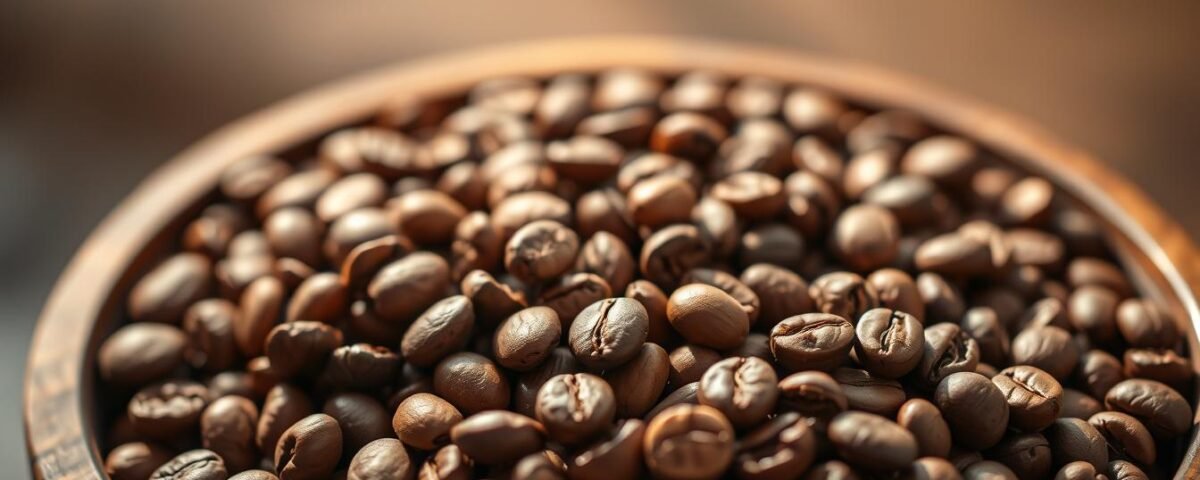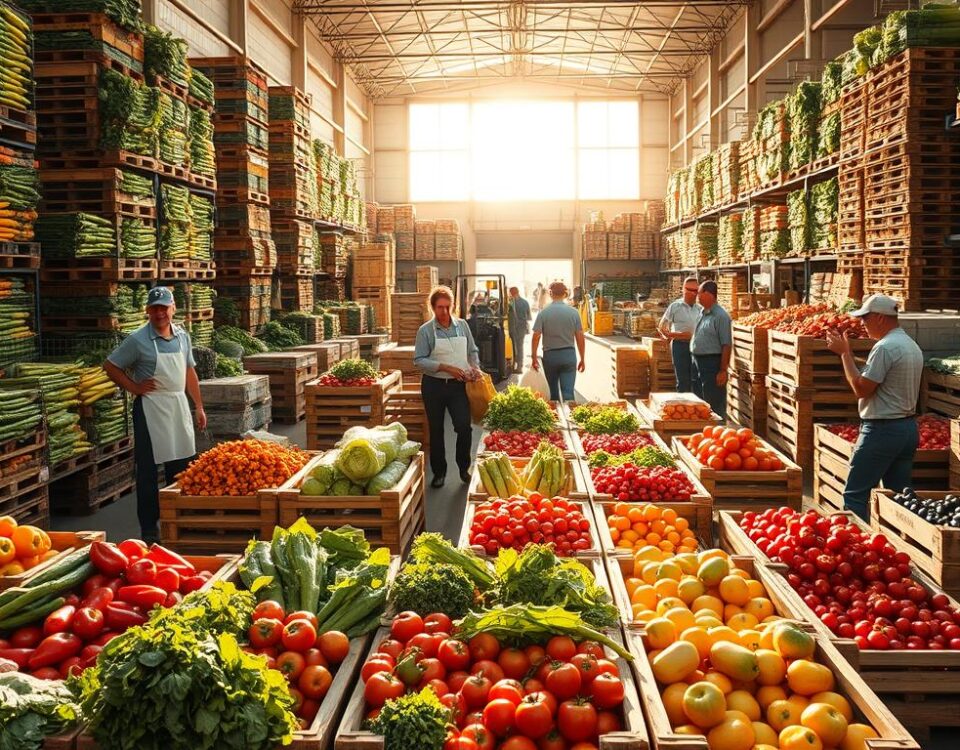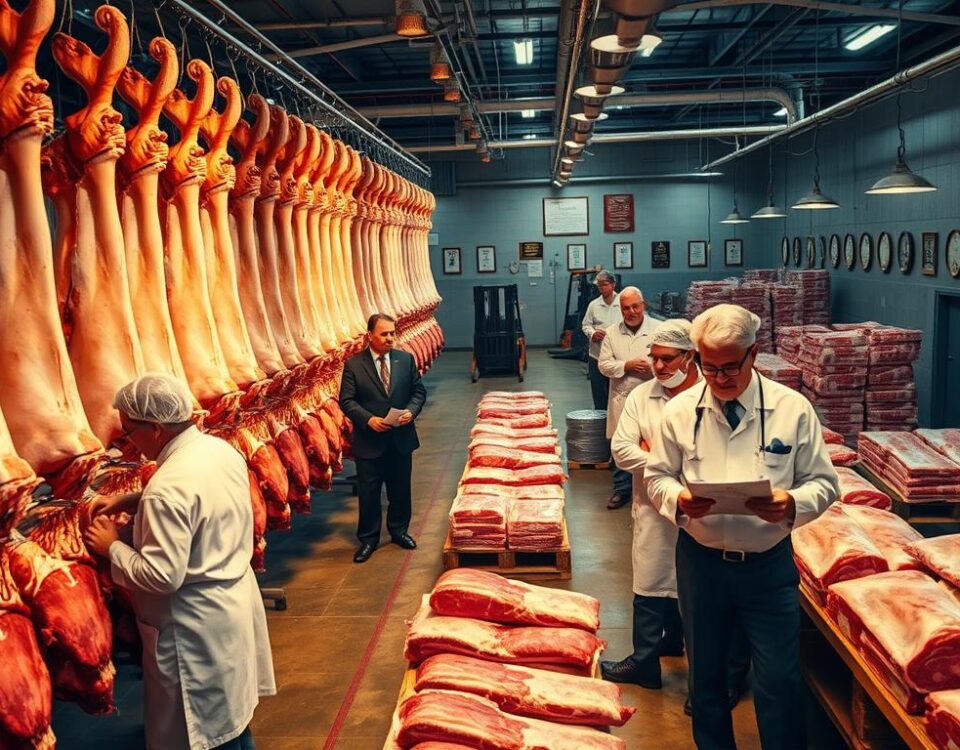
The 5 Most Common Coffee Brewing Mistakes (And How to Avoid Them)
April 17, 2025
How Water Temperature Affects Your Coffee Taste—Science Explained
April 18, 2025There’s something magical about the first sip of a morning brew. For years, I thought my local café held the secret to that perfect cup—until I discovered the real hero: the beans. It wasn’t until I brought home a mismatched bag of dark roast on a whim that I realized how much control we truly have over our daily ritual.
I’ll never forget the day I brewed a single-origin Ethiopian light roast. The floral notes danced on my tongue, completely unlike the bitter, over-roasted blends I’d settled for before. That moment changed everything. Suddenly, terms like “acidity” and “body” weren’t just words on packaging—they became the building blocks of my morning joy.
Through trial, error, and countless cups, I learned that great home brewing starts long before water hits grounds. It begins with understanding what’s in that carefully curated bag—the origin stories, roast profiles, and flavor potentials waiting to unfold. Whether you’re using a French press or a pour-over setup, the journey from bean to brew becomes deeply personal once you know what to look for.
Key Takeaways
- Your beans’ origin and roast level dramatically shape your brew’s character
- Light roasts highlight fruity notes, while dark roasts offer bold richness
- Freshness matters more than fancy equipment for café-quality results
- Single-origin beans tell a terroir story; blends create balanced flavors
- Proper storage in airtight containers preserves complex aromas
Exploring the World of Coffee Beans
My journey into coffee’s kaleidoscope began when I accidentally bought a bag labeled “100% Robusta.” The intense, almost smoky flavor shocked me—until I realized how much bean variety shapes our experience. Each type carries distinct fingerprints of soil, climate, and craft.
Understanding Arabica and Robusta Varietals
Arabica beans spoiled me first. Grown in Ethiopia’s highlands, they deliver floral highs and caramel sweetness. But Robusta coffee surprised me later—its bold, earthy punch works magic in espresso blends. I learned Arabica has half the caffeine but twice the acidity of its resilient cousin.
Other Notable Coffee Bean Types and Origins
Liberica beans from Malaysia taught me about rarity. Their woody, almost spicy notes feel like sipping liquid incense. Then there’s Excelsa—a Vietnamese treasure with tart fruitiness. Higher altitudes often mean slower growth, creating denser beans with layered flavors.
How Bean Origin Shapes Taste and Acidity
Colombian beans from misty mountains burst with bright citrus. Kenyan ones? They’re all berry zing. Soil minerals and rainfall patterns write these flavor scripts. Single-origin bags let you taste a region’s soul, while blends harmonize contrasts—like a Brazilian base smoothing Ethiopian brightness.
Roast Levels and Flavor Profiles
I once mistook a light roast for dark—turns out color speaks volumes about flavor. Roasting unlocks hidden dimensions in every bean through precise heat application. This alchemy transforms grassy raw seeds into aromatic treasures bursting with personality.
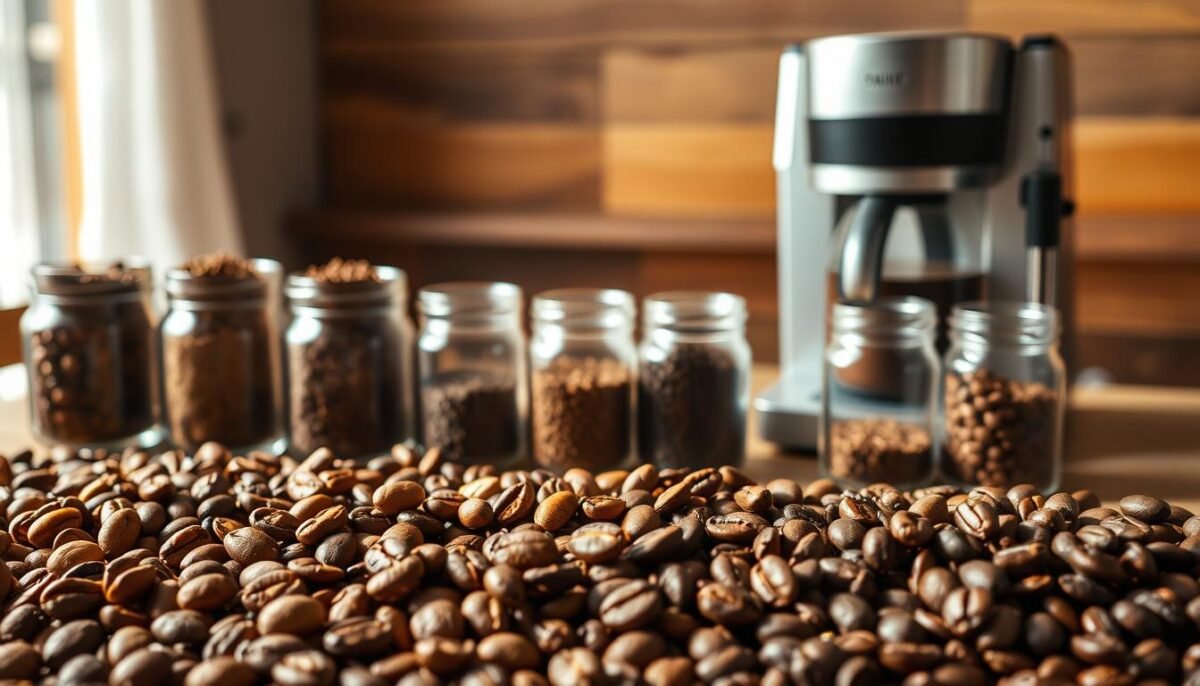
Light, Medium, and Dark Roasts Explained
Light roasts stop at “first crack,” preserving citrusy brightness. Their matte surface hides explosive floral notes I discovered in Guatemalan beans last spring. Medium roasts reach caramelization phase—think milk chocolate tones with balanced acidity.
| Roast Level | Bean Color | Oil Presence | Flavor Range | Caffeine % |
|---|---|---|---|---|
| Light | Cinnamon | None | Lemon, Jasmine | 1.37 |
| Medium | Milk Chocolate | Speckled | Caramel, Nutmeg | 1.19 |
| Dark | Espresso Black | Glossy | Smoke, Dark Cocoa | 0.83 |
Matching Roast Levels to Your Flavor Preferences
My friend Sarah thought she hated coffee until trying a honey-processed light roast. Dark roasts work wonders for creamy lattes, while medium ones shine in drip brewers.
“Roast level is your compass—it directs but doesn’t dictate the journey,”
says Texas roaster Carla Reyes.
Try this: Brew three roasts side-by-side. Notice how acidity mellows as roast time increases. Lighter profiles highlight origin stories; darker ones showcase the roaster’s craft. Your perfect cup awaits where these elements harmonize.
Tips to Choose best coffee beans for Home Brewing
I still remember the thrill of finding my first “roasted on” date stamp. That tiny print transformed how I shop for beans—suddenly, freshness became tangible. Your local store holds treasures if you know where to look.
Shopping for Fresh and Ethically Sourced Beans
Always check two dates: roast and expiration. Opt for bags roasted within 3 weeks—their matte surface means oils haven’t oxidized yet. I’ve learned to spot quality markers:
| Feature | Supermarket Bags | Local Roaster |
|---|---|---|
| Roast Date Visibility | Often missing | Front label |
| Certifications | Generic | Direct Trade/Fair Trade |
| Price Range | $8-12 | $14-20 |
| Freshness Window | 6-12 months | 3-4 weeks |
Ethical sourcing matters beyond feel-good labels. Look for specific farm names rather than vague regions. My rule? If the “origin story” feels generic, the flavor might be too.
Tasting Techniques and Experimenting With Flavors
Grind samples differently than your usual method. Coarse grounds reveal acidity; fine ones emphasize body. Try this comparison:
- Single-origin: Focus on dominant notes (citrus, cocoa)
- Blends: Notice how flavors layer (nutty base + floral finish)
“Your tongue maps flavors better when you sip water between tastes,”
Store beans in airtight containers away from sunlight. Heat and moisture are flavor thieves—I learned this after my kitchen cabinet ruined two bags. Now, my countertop canister keeps aromas vibrant for weeks.
Enhancing Your Brew Method for Daily Perfection
My morning ritual transformed when I realized my blade grinder was sabotaging my espresso. That harsh metallic whir created uneven particles—some powdery dust, others gravel chunks. Upgrading to a burr grinder taught me how precise ground consistency unlocks flavors I never knew existed.
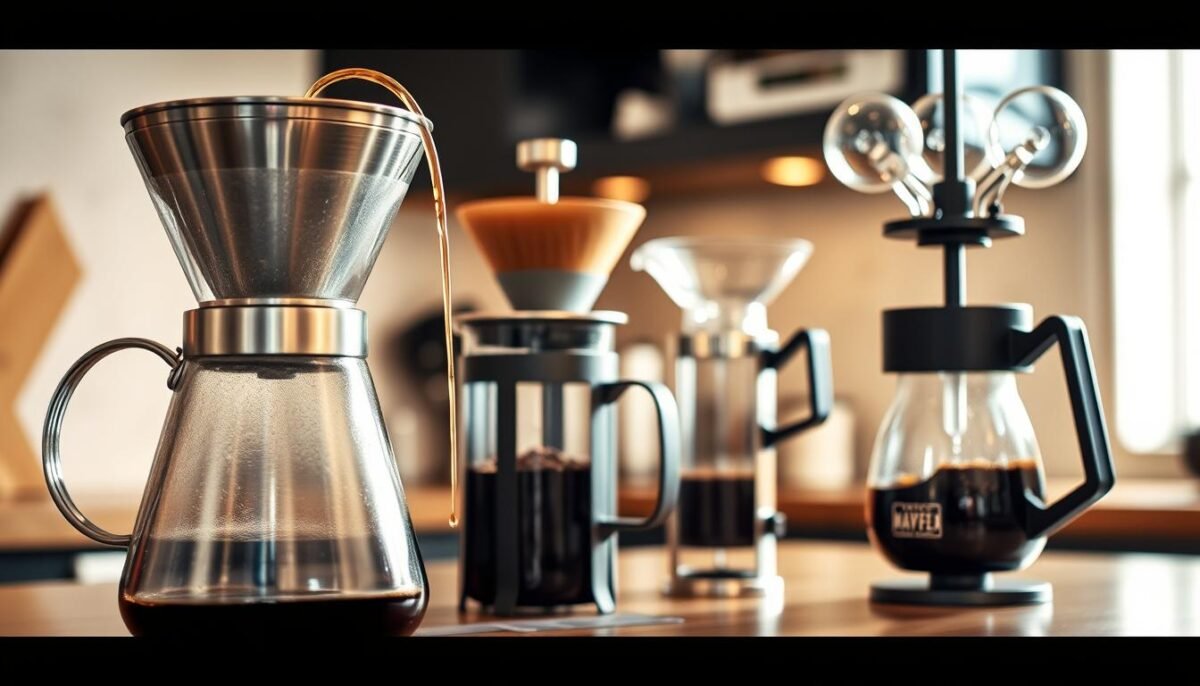
Adjusting Grind Types for Different Brewing Methods
Your grind size acts like a flavor gatekeeper. For drip coffee, aim for sea salt texture—too fine causes bitterness. Cold brew thrives with coarse grounds that steep slowly without over-extracting. Here’s how I match particle size to my setup:
| Brew Method | Grind Size | Water Temp | Brew Time | Flavor Impact |
|---|---|---|---|---|
| Espresso | Fine Powder | 200°F | 25-30 sec | Intense, syrupy |
| French Press | Coarse | 195°F | 4 min | Full-bodied |
| Pour Over | Medium-Fine | 205°F | 2.5 min | Bright acidity |
| Cold Brew | Extra Coarse | Room Temp | 12-24 hrs | Mellow sweetness |
Leveraging Equipment for Consistent Quality
My $20 scale became a game-changer. Measuring 18g beans for espresso instead of eyeballing it brought caramel notes forward. A gooseneck kettle’s precise flow makes pour-over circles even—no more weak spots in the bed.
Temperature control matters more than I thought. Drip coffee machines often brew too cool (185°F vs ideal 195-205°F). I now preheat my French press with boiling water while grinding. These tweaks cost nothing but elevate every cup.
“Your last sip should taste as good as your first—that’s when you know your method works.”
Experiment with ratios next week. Try 1:15 (beans to water) for lighter roasts, 1:13 for darker ones. Small changes create ripples in your daily ritual. Your perfect brew awaits where science meets personal preference.
Conclusion
Discovering coffee’s depth feels like learning a new language—every flavor profile tells stories of soil and craft. Through exploring arabica’s floral highs and robusta’s earthy punch, I’ve realized our mugs hold entire worlds.
Freshness transforms everything. Those roast dates on local bags? They’re expiration timers for vibrant notes. Storing beans in airtight containers preserves citrus zing or cocoa richness longer than you’d expect.
Your grind size and water temperature aren’t just details—they’re dials for adjusting acidity and body. A medium roast might sing in your French press but whisper in espresso. That’s the joy: methods and roasts dance differently in every kitchen.
Trust your tongue more than trends. My worst brew taught me more than my best ever did. Revisit sections when stuck—sometimes a tweak to your ratio or steep time unlocks hidden caramel tones.
Now go taste that Liberica you’ve been eyeing. Let each sip remind you: great mornings start with curiosity, not perfection.
FAQ
What’s the main difference between Arabica and Robusta?
I prefer Arabica for its sweeter, nuanced flavors and lower caffeine, while Robusta packs a stronger, earthy punch with higher acidity. The choice depends on whether you prioritize smoothness or intensity in your daily cup.
How does bean origin affect my brew’s taste?
Regions like Ethiopia or Colombia impact flavor profiles through altitude and soil. For example, beans grown at higher elevations often have brighter acidity and floral notes, which I love for pour-over methods.
Can I use dark roast for cold brew?
Absolutely! Dark roasts add rich, chocolatey depth to cold brew. I’ve found that coarsely ground beans work best to balance bitterness and highlight those caramelized roast notes.
What grind type suits a French press?
A coarse grind is my go-to for French press—it prevents sludge and lets the full-bodied flavors shine. Too fine, and you’ll end up with over-extracted, muddy results.
How do I ensure my beans are ethically sourced?
Look for certifications like Fair Trade or Rainforest Alliance on the bag. I also prioritize roasters like Counter Culture or Stumptown, who openly share their sourcing practices and farmer partnerships.
Why does my espresso taste sour?
Under-extraction is usually the culprit. Try adjusting your grind to be slightly finer or extending the brew time by a few seconds. Freshly roasted beans (within 3 weeks) also make a huge difference!
Should I buy pre-ground or whole bean?
Whole bean all the way! Grinding right before brewing preserves oils and aromas. My Baratza Encore grinder gives me consistent results whether I’m making drip or AeroPress.
How long do roasted beans stay fresh?
I use mine within 2-4 weeks of the roast date for peak flavor. Store them in an airtight container away from light and heat—never in the fridge, as moisture ruins texture.
Can blending different roasts improve flavor?
Yes! Mixing a bright Ethiopian light roast with a nutty Brazilian medium roast creates balance. Experiment with ratios—I start with 70% base bean and 30% accent for unique daily cups.
What equipment upgrades boosted your home brewing?
A gooseneck kettle for precise pour control and a digital scale improved my consistency. For espresso lovers, the Breville Bambino Plus is a game-changer without breaking the bank.
